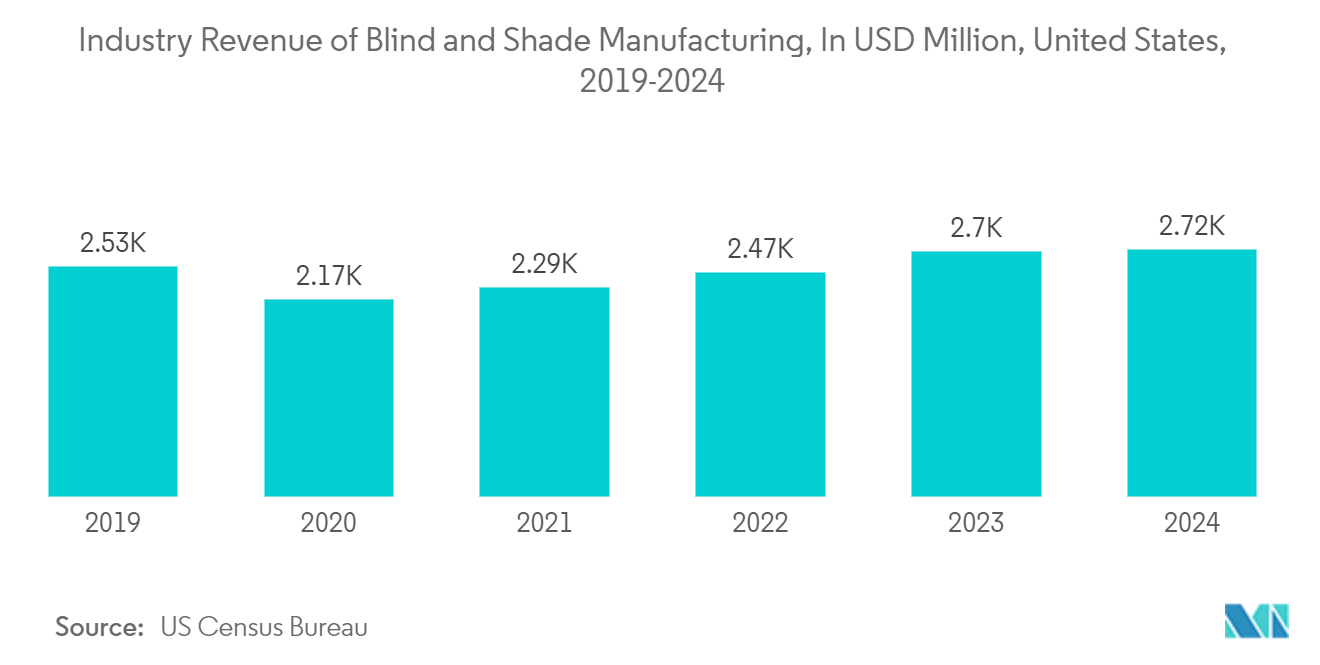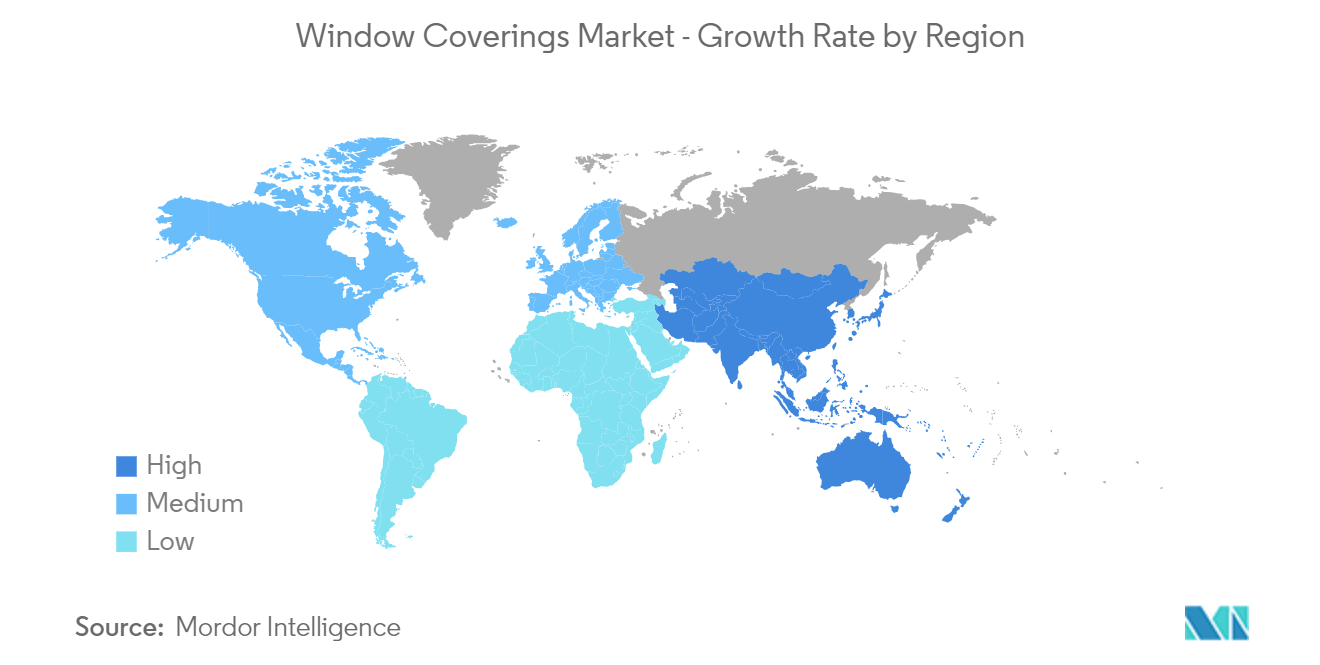Market Trends of Window Coverings Industry
Blinds Segment is Expected to Hold Significant Share
- Blinds are a significant option for residential or rental applications because they are among the least expensive window coverings. A 2-by-4-foot window can have miniblinds made of aluminum or conventional vinyl for a very affordable price. Further, blinds are available in various materials, colors, and designs, allowing consumers to customize their window coverings to match their interior décor. The growing trend of personalized home interiors has contributed to the popularity of blinds.
- In addition, blinds can help control natural light, which improves health by improving sleep patterns and reducing glare. This awareness is influencing consumer choices toward window coverings that offer health-related benefits. These are often more affordable than window coverings like curtains or shades, making them an attractive option for budget-conscious consumers.
- The rise of smart homes has driven demand for motorized and automated blinds that can be controlled remotely or through voice commands. Integrating smart home systems offers convenience and modern functionality, making blinds a popular choice. For instance, the European Commission announced that 112 cities were selected to participate in the EU Mission for 100 climate-neutral and smart cities by 2030, also known as the Cities Mission. The designated cities, 100 from all 27 EU countries and 12 from Horizon Europe-associated countries, are receiving tailor-made advice and support from the Mission Platform, managed by NetZeroCities, to reach climate neutrality by 2030 and inspire other cities to follow suit by 2050.
- Along with the rising trend of installing intelligent systems in homes, the installation of automated roller blinds is also rising in the market studied. These window coverings can be controlled through various mobile applications. They can readjust position with the outdoor and indoor temperatures and are expected to become a stable alternative to traditional blinds in smart homes during the forecast period.
- Furthermore, the growing emphasis on energy efficiency and sustainability drives the demand for blinds window coverings in the United States. This prompts consumers to invest in window coverings that offer insulation and light control benefits. This trend is further fueled by rising awareness of environmental issues and the desire to reduce energy consumption. According to the US Census Bureau, it is projected that the revenue of blind and shade manufacturing in the country will account for approximately USD 2,719.7 million in 2024.
- Moreover, increased awareness about eco-friendly window blinds, such as recycled blinds, is expected to positively impact the region's window blinds business growth during the forecast period. In addition, in June 2024, LC Dynamics introduced its significant solar panel window blinds. While they mimic the classic Venetian style, each slat is an ingeniously crafted solar panel from repurposed materials. Furthermore, an integrated motorized system lets the slats rotate automatically, maximizing solar energy capture throughout the day.

Asia-Pacific is Expected to Witness Significant Market Growth
- The segment explores the ongoing trends and drivers for window coverings in various Asia-Pacific countries. The region is marked by multiple vendor activities and a viable customer base, facilitating the expansion of window coverings sales in the countries and presenting firm opportunities for companies operating in the market studied.
- Rapid urbanization in countries like China, India, and Southeast Asia leads to increased residential construction. As more people move to urban areas and new housing developments arise, the demand for home interior products, including window coverings, grows. According to the urbanization blueprint released by the Communist Party and State Council, China targets 70% urbanization by 2030.
- The rise of smart home device manufacturers has significantly boosted the adoption of smart home technologies in South Korea. The government initiatives and investment policies have further propelled the nation's production and consumption of smart window coverings. A prime example is the Korea Information and Communication Technology Association (KOIT) partnership with the Korea Land and Housing Company. The latter, a semi-governmental entity, is responsible for urban land and housing development. Their joint endeavor is an ambitious project to create a connected home platform, leveraging the secure IP framework for devices.
- Furthermore, China's rapidly expanding real estate sector, driven by urbanization and infrastructure development, fuels demand for blinds window coverings. In 2023, commercialized real estate sales in China generated a total revenue of approximately CNY 11.7 trillion (USD 1.64 trillion), as reported by the National Bureau of Statistics of China. This revenue encompasses residential real estate sales, office properties, commercial real estate, and other transactions facilitated by Chinese real estate developers.
- Asia-Pacific is characterized by diverse consumer preferences influenced by varying cultural and climatic conditions. This diversity leads to a wide range of window covering products being in demand, from traditional curtains to modern blinds and shades. In some countries, government initiatives promoting energy-efficient buildings and sustainable practices are encouraging the use of window coverings that contribute to energy conservation, further boosting the market.
- According to IBEF, under the Interim Union Budget 2024-25, the Smart Cities Mission in India has been allocated INR 2,236 crore (USD 268.43 million) compared to INR 7,535 crore (USD 904.56 million) in FY24. Further, the total allocated investments for the Smart City Mission stood at INR 7,20,000 crore (USD 86.43 billion) as of February 2024. Government initiatives in expanding smart cities may further propel the market’s growth in the region.


